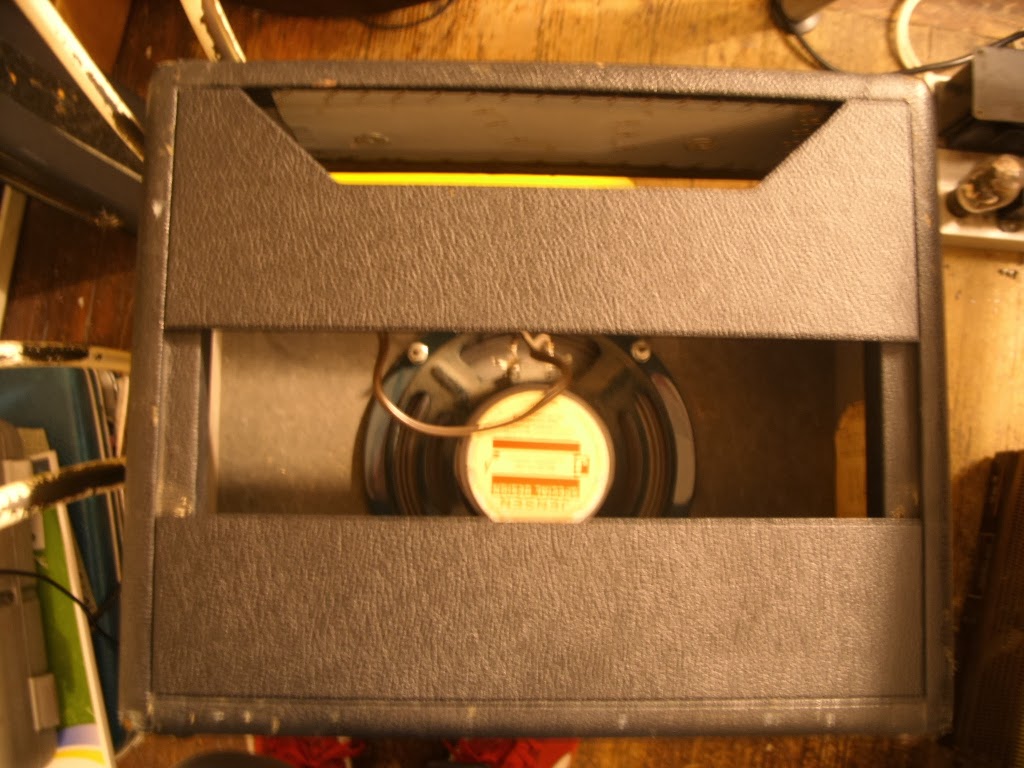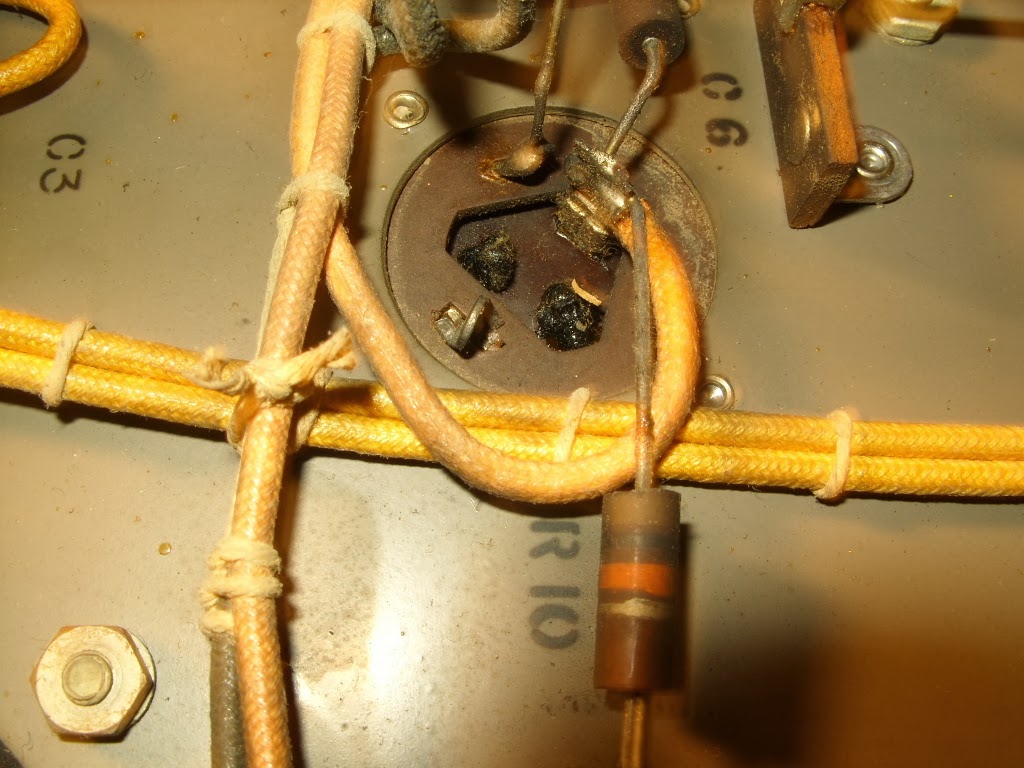This road warrior came to me the other day in sad shape. Really bad tone, volume drop, splatty distortion and noisy. Upon first observation one of the JJ 6L6 tubes had overheated, the red paint had turned completely brown. I figured maybe it had blown that tube but the fuse hadn't blown and the amp still worked. Each tube tested good.
The culprit? A number of issues. First, whoever installed these tubes did a really poor job of it. In the Mesa bias circuit there are 2 resistors running parallel to ground, a 10k and a 6k. There is a myth I've heard many times that Mesa amps are 'self biasing'. This isn't true at all. I've also heard that maybe Mesa perpetuated that myth so they can sell Mesa branded tubes that are selected to run safely in the amp due to what the bias is set at. Regardless there is no truth to this. You replace the tubes, you need to re-bias the amp. These do not have a bias trim pot so you need to replace those resistors or install a bias pot to get it right.
And, coupled with the fact that they replaced those 2 resistors with a 15k resistor taking the bias voltage from -52 to -60+ volts you have an amp that is biased way too cold. Then you have JJ tubes. You need to bias JJ tubes differently in general. They tend to run cold under normal circumstances. In this case they were drawing a whopping 2-4milliamps each. Barely enough for the tube to open.
So first we experiment with resistors. I didn't wind up installing a trim pot today, I did wind up installing 2x 4.7k resistors in parallel to get a bias of 29-30ma per tube.
So what about that tube that got too hot? At some point in this amps life a couple of very small value caps were installed from pin 5 (control grid) to ground. I assume these are to kill some very high end oscillation. One of them was shorting creating a bias voltage drop on that tube thus drawing far too much current. I pulled them out and tossed them. Next, replaced the 470 ohm 2 watt screen grid resistors, 2 of them were charred. Fortunately this is a good set of JJ tubes. If you get a good set they last, they are tough and can handle the abusive environment inside a high gain amp like this. Other choices are the good ol' Sovtek 5881. A Chinese tube would have been toast most likely. Choose wisely.
If you look carefully I did install a couple of 1 ohm 1 watt resistors from pin 8 to ground. This is the easy way to measure bias.
Next the preamp. Noisy and cutting volume. There were a number of things that needed to be addressed. The rice crispies and milk sound was simply a bad preamp tube, the dropouts were from cap failure.
I replaced the filter cap feeding the first preamp tubes and the cathode caps on the first stage tube. This cleaned that problem right up. The rest was routine maintenance. Tighten the pots and jacks, clean the sockets and pots.
Mesa amps are complicated beast. I enjoyed this one, up to the Mk2 I usually do. Once you get into the later amps you are dealing with double sided circuit boards, heat issues, a repair mans nightmare. I usually turn them away. It's very easy to spend as much time on one trying to track out one problem and it takes to overhaul an old Fender or Marshall. They are not a beginner amp! I like Mesa for this:
http://www.mesaboogie.com/manuals/Mark%20I%20Maint-Repair.pdf
Publishing a repair manual for all to see. That's classy. I've dealt with them on the phone and they have been super supportive and cool. They stand by their products. That's rare in today's world. These older ones are BEAST. I remember the first one I ever played. It knocked a half stack away with that single 12" speaker. These early ones are built like a tank so if you happen upon one, they may be one of the most versatile amps you can find.
Thanks for reading and happy soldering! JB
The culprit? A number of issues. First, whoever installed these tubes did a really poor job of it. In the Mesa bias circuit there are 2 resistors running parallel to ground, a 10k and a 6k. There is a myth I've heard many times that Mesa amps are 'self biasing'. This isn't true at all. I've also heard that maybe Mesa perpetuated that myth so they can sell Mesa branded tubes that are selected to run safely in the amp due to what the bias is set at. Regardless there is no truth to this. You replace the tubes, you need to re-bias the amp. These do not have a bias trim pot so you need to replace those resistors or install a bias pot to get it right.
And, coupled with the fact that they replaced those 2 resistors with a 15k resistor taking the bias voltage from -52 to -60+ volts you have an amp that is biased way too cold. Then you have JJ tubes. You need to bias JJ tubes differently in general. They tend to run cold under normal circumstances. In this case they were drawing a whopping 2-4milliamps each. Barely enough for the tube to open.
So first we experiment with resistors. I didn't wind up installing a trim pot today, I did wind up installing 2x 4.7k resistors in parallel to get a bias of 29-30ma per tube.
So what about that tube that got too hot? At some point in this amps life a couple of very small value caps were installed from pin 5 (control grid) to ground. I assume these are to kill some very high end oscillation. One of them was shorting creating a bias voltage drop on that tube thus drawing far too much current. I pulled them out and tossed them. Next, replaced the 470 ohm 2 watt screen grid resistors, 2 of them were charred. Fortunately this is a good set of JJ tubes. If you get a good set they last, they are tough and can handle the abusive environment inside a high gain amp like this. Other choices are the good ol' Sovtek 5881. A Chinese tube would have been toast most likely. Choose wisely.
If you look carefully I did install a couple of 1 ohm 1 watt resistors from pin 8 to ground. This is the easy way to measure bias.
Next the preamp. Noisy and cutting volume. There were a number of things that needed to be addressed. The rice crispies and milk sound was simply a bad preamp tube, the dropouts were from cap failure.
I replaced the filter cap feeding the first preamp tubes and the cathode caps on the first stage tube. This cleaned that problem right up. The rest was routine maintenance. Tighten the pots and jacks, clean the sockets and pots.
Mesa amps are complicated beast. I enjoyed this one, up to the Mk2 I usually do. Once you get into the later amps you are dealing with double sided circuit boards, heat issues, a repair mans nightmare. I usually turn them away. It's very easy to spend as much time on one trying to track out one problem and it takes to overhaul an old Fender or Marshall. They are not a beginner amp! I like Mesa for this:
http://www.mesaboogie.com/manuals/Mark%20I%20Maint-Repair.pdf
Publishing a repair manual for all to see. That's classy. I've dealt with them on the phone and they have been super supportive and cool. They stand by their products. That's rare in today's world. These older ones are BEAST. I remember the first one I ever played. It knocked a half stack away with that single 12" speaker. These early ones are built like a tank so if you happen upon one, they may be one of the most versatile amps you can find.
Thanks for reading and happy soldering! JB
































